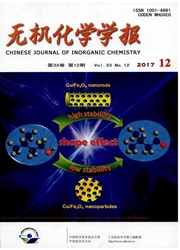

 中文摘要:
中文摘要:
采用聚丙烯酰胺(PAM)为软模板。在CuSO4、Na2SO3体系中调控合成了片状、海胆状、一维线、针状聚集体氧化亚铜晶体。研究了不同浓度Cu2+、不同PAM含量及不同温度对晶体生长的影响。结果表明.PAM促使氧化亚铜异相成核,氧化亚铜形貌随PAM质量分数的变化而变化:当c(Cu2+)=0.5mol.L^-1时,PAM质量分数为3.0%(常温引入体系),产物主要为片状晶体;PAM质量分数为1.O%、3.0%时(高温引入体系),分别获得一维线状、海胆状晶体;当Cu2+浓度为0.1mol·L^-1时,体系中高温引入质量分数3.0%的PAM,得到片层状晶体:当Cu2+浓度为0.3、0.4mol·L^-1时,得到针状聚集体氧化亚铜晶体。分别用X射线粉末衍射、冷场发射扫描电子显微镜和激光粒度仪对所制备的产品进行了表征.
 英文摘要:
英文摘要:
One-dimensional nanowires, sheet-like, sea urchin-like and needle-like aggregations were prepared in the presence of polyacrylamide (PAM) as the template. The effects of mass fraction and temperature of PAM and concentration of copper salt on crystal growth were investigated. The result showed that the shape of the resulted cuprous oxide crystallites could be well controlled by adjusting the PAM concentration. Sheet-like Cu2O particles were produced when the PAM reached 3.0% at room temperature. One-dimensional nanowires and sea urchin- like Cu2O particle were obtained respectively by adding PAM solutions of 1.0% and 3.0% in 100 degree. Laminar-like and needle-like aggregations of Cu2Owere prepared respectively by adding different concentrations of copper salt at 0.1, 0.3, and 0.4 mol· L-1 at high temperature and ω (PAM) reached 3.0%. The products were characterized by X-ray powder diffraction (XRD), scan electron microscopy (SEM) and particle size distribution.
 同期刊论文项目
同期刊论文项目
 同项目期刊论文
同项目期刊论文
 期刊信息
期刊信息
